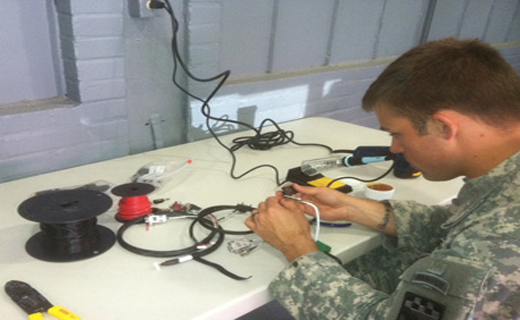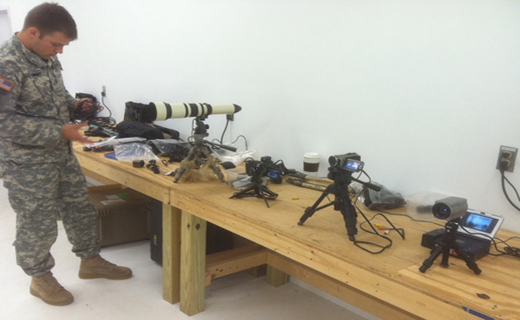Tagging, Tracking and Locating: Intelligence-Gathering in Support of Army 2020


As the Army continues to define the structure and doctrine of Army 2020, lessons-learned from 13 years of war in Iraq and Afghanistan – and applying these lessons to wide-area security, stability and combined-arms maneuver operations – have become a cornerstone of building that Army. The counterinsurgency (COIN) environment generated new processes and programs across the doctrine, organization, training, materiel, leader development, personnel and facilities (DOTMLPF) domains. Intelligence-gathering is no exception; the insurgent / counterinsurgent environment drove the need for audiovisual, tagging, tracking and locating (TTL) capabilities. These capabilities provided the combat commander with the ability to pinpoint and remove hostile forces embedded in civilian populations while reducing collateral damage and building a network of information addressing all aspects of the COIN fight.
One of the materiel solutions that has provided commanders with those exact capabilities is the Close-Access Target Reconnaissance (CATR) system. CATR is an assembled kit of technical audio and visual surveillance equipment as well as electronic TTL devices that has been used with great success within the Department of Defense communities to gather information in support of COIN operations. Although this capability was developed in support of the COIN environment, it has applicability to conventional warfare in the arena of reconnaissance formations.
CATR influences the fight in that it allows the commander and his staff to continuously monitor targets and named areas of interest in the operational environment, assess that environment and evaluate the threat. CATR is capable of employment and monitoring with minimal impact to the Soldier’s workload. Once employed, there is no requirement for Soldiers to remain on the battlefield until recovery of the equipment is required. Some CATR equipment can be monitored from friendly unit locations, while other pieces of equipment must be recovered and evaluated. Previously CATR had been issued to battlefield surveillance brigades (BfSB) and brigade combat teams (BCT), but it now has the flexibility to provide various capabilities tailored to subordinate echelons and their collection requirements. Subcomponents can be used by commanders / leaders or can be emplaced, monitored or operated by specially designated and trained Soldiers.
What is CATR?
CATR is a unique technical reconnaissance capability that enables commanders and subordinate leaders to gather information on predominantly asymmetric threats operating across a wide range of military operations and act in a timely and decisive manner to defeat the enemy threat. It is an integrated set of devices, kits, software, support equipment and training that provides the warfighter a technical reconnaissance, surveillance and information-collection capability that has demonstrated its effectiveness during recent combat operations. The program addresses the evolutionary changes to technology while supporting force-protection requirements, and it augments existing all-source intelligence analysis and targeting programs. It enhances information collected from TTL operations to be integrated into a unit’s intelligence collection, mission planning and targeting cycles.
The CATR program covers two primary capabilities. First is the use of TTL equipment to geolocate a position on the ground through global positioning with either real-time devices observed through the network or loggers that can be emplaced and then downloaded at a later time by retrieving or gaining proximity to their location. The second aspect of the program involves the use of technical, audio, visual and surveillance (TAVS) equipment to record either audio or video using small, high-quality recorders. The TTL and TAVS equipment consists of devices that can be tailored to suit a variety of reconnaissance, surveillance and information-collection missions. The items in the set can be employed using standard batteries, fabricated battery packs or external alternating current / direct current power. Also, the CATR set includes an installation kit and basic electronics kit used for installation and fabrication to meet unit mission requirements.
During employment, the CATR set uses a government system called Keymaker, which is composed of a network administration server called “Unitrac” and a mapping visualization tool with analyst tools built in called “Raptor X.” This system enhances the commander’s common operational picture through a tactical unit’s ability to use the robust data-sharing architecture and a common graphical user interface. This allows the operator to conduct long-term/fused analysis of TTL data. These devices give the commander an enhanced force-protection capability when conducting operations in a variety of environments.
History
An operational-needs statement was submitted and approved in 2005 to provide units with TTL capability. The Joint Improvised Explosive Device Defeat Organization took the lead in developing a kit made up of commercial-off-the-shelf equipment that fit the identified requirement. Since then, the capabilities of the CATR system have increased as technology has matured. CATR was used successfully within the conventional force communities, giving commanders TTL capabilities enhanced with audio- and video-recording options. As the conflicts in Iraq and Afghanistan matured, organizations used the CATR capabilities to build an intelligence database populated with viable targets, which in turn allowed combat commanders to develop target packages and direct resources to maximize success with decisive results.
Current kits
The current CATR kits consist of several types of audio- and video-recording devices and TTL equipment. This gives the user several types of employment options that are useful in different technological mediums, depending on the host environment’s technology infrastructure. There is enough of each type of equipment to support information-gathering on multiple targets simultaneously.
Current training
The current CATR training program relies primarily on contracted field service representatives (FSRs) and contracted trainers provided by the Program Manager (PM)-Military Departments. New-equipment training (NET) mobile training teams (MTT) currently go to a deploying unit’s desired training location to conduct an extensive 20-day CATR training course designed to bring members of the unit up to a level of expertise that will allow them to successfully employ the TTL and TAVS surveillance equipment. This course is not military-occupational-specialty specific.
Students learn basic electronics that includes identification of appropriate electronic formulas, calculations and how to build power supplies. Students also learn camouflage and fabrication techniques. Unit members learn target reconnaissance, which teaches them how to place devices to enhance information-collection efforts in support of the commander’s priority intelligence requirements. Students learn how to retrieve the information and, most importantly, how to analyze the data gathered to inform the operational commander of enemy activity in a unit’s area of operation.
Upon completion of NET, the unit signs for the CATR equipment (about three wooden pallets). All this follows final equipment operations testing, which is conducted throughout the duration of that 20-day training course as it is being used. Any equipment identified as unserviceable during this training is replaced right away.
Currently, FSRs are at the Maneuver Center of Excellence (MCoE); the Intelligence Center of Excellence; certain divisions; both the National Training Center (NTC) and the Joint Readiness Training Center (JRTC); and all current BfSB locations. These FSRs provide command and staff CATR education, CATR sustainment training, maintenance of equipment, evaluation of the unit’s CATR readiness, software diagnostics and deconfliction, and assistance in developing realistic training scenarios to exercise the capability. Internal to the MCoE, CATR information briefings began in mid-2012 as part of the Maneuver Captain’s Career Course, Army Reconnaissance Course and Maneuver Senior Leader’s Course, with the potential for more detailed and hands-on training opportunities for CATR in the future.
Program of record
The success of the CATR system and the need for precise intelligence-gathering has prompted the Department of the Army (DA) to transition the system from a Capabilities Developed for Rapid Transition-14 acquisition program candidate to become an actual Army program of record. That decision was made by the Army’s vice chief of staff in June 2012.
The Army G-8 decided to place the CATR project under the Program Executive Office (PEO) for Intelligence and Electronic Warfare Systems, to be managed by PM-Ground Sensors. PM-Ground Sensors – working in concert with the MCoE, U.S. Army Training and Doctrine Command (TRADOC), U.S. Army Forces Command (FORSCOM) and the other Army centers of excellence – has developed and submitted supporting production documentation to support CATR’s competition for future Army funding. This plan will allow fielding of the CATR system to every BCT in the Army at a rate of eight to 10 brigades a year. An initial fielding timeline to the first units is still to be determined at this time.
Future kit design
The current CATR funding and fielding plan calls for a base kit designed to train units on use of the TTL and TAVS components. A more robust kit will be issued if a unit is designated for deployment. This more enhanced kit will be made up of the same equipment that makes up the base kit but will consist of more of each type of TTL and TAVS devices. If a unit is required to deploy in support of combat operations, it will receive its equipment prior to departure, or the unit will draw its equipment once in theater. The unit will receive more of each type of equipment, allowing a greater capability to gather information.
As initial and subsequent fielding takes place, only in certain instances will a unit receive enhanced kits made up of equipment not in its base kit. As technology matures, PM-Ground Sensors will purchase and field new components to the base kits. This process may lead to units deploying with enhanced kits containing equipment the unit has not seen before. In these instances, units will receive modified NET to ensure the unit is proficient in using its new devices.
Future training
The future training plan and cost constraints will necessitate the termination of the FSRs except at combat training centers. Brigades will be required to designate a unit CATR subject-matter expert (SME), who will receive training at designated locations. Funds for this training will come from the PM and not from unit training dollars. This training will be coordinated to end and coincide with the NET process that will take place when a brigade is fielded its CATR system. The new brigade SME will assist the CATR MTT with the equipment fielding and with supporting the NET training courses. Once NET is complete, the brigade SME will coordinate to conduct sustainment training in conjunction with the brigade’s established training plans.
Institutional training for the CATR system will also be vital to the program’s success. As the proponent for CATR, the MCoE is looking to the future of CATR training. The goal is to develop and fund CATR training at Fort Benning, GA, to enhance the capabilities of units that will deploy with and use the TTL and TAVS capabilities the system will provide. The MCoE has already taken the first steps in this process and will work to develop a skill identifier not only for future CATR training recipients but also for those Soldiers who have trained on the system previously and have supported combat operations in Iraq and Afghanistan.
Ten years of war in the Middle East fighting an enemy that can blend into the population have demonstrated the need for a more thorough ability to find and positively identify that enemy. The identification and destruction of enemy support networks, capabilities and removing the enemy threat while successfully building positive relationships with local populations are vital aspects that support the Army of 2020. Unmanned aerial systems, communications-network advances and advances in technology are examples of the continuing strides forward that will allow U.S. and coalition partners to identify and target that enemy more effectively. The CATR system and its proven effectiveness falls into this category, and the capabilities the platform brings to current and future battlefields will enhance the Army’s combat effectiveness in both current and future operations.
Organizations or personnel desiring more information about CATR are encouraged to contact the TRADOC Capability Manager (TCM)-Armored Brigade Combat Team (ABCT) / Reconnaissance at the MCoE. Contact information can be found on the MCoE Website at www.benning.army.mil/mcoe.
 email
email print
print